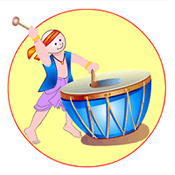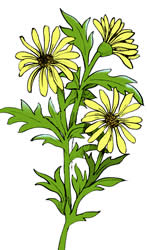
Dimdima
Online Children's Magazine from India

Dimdima
Online Children's Magazine from India

The compass plant, a native of the North American midwest, has large leaves cut into several lobes. The leaves tend to line up edgewise in a north-south direction, like a compass. Early travellers across the prairies used this plant to find out the directions, so another name for it is pilotweed. The plant itself aligns its leaves in this way to escape the strong midday sun and receive the gentler early morning and late after-noon sunlight instead.
It is easy to mistake the compass plant’s sunny yellow blossoms for sunflowers, but there are differences. The thick, hairy stem contains a sap or rosin. Also, the seeds are not contained in the flat disk at the centre like in the sunflower.
The compass plant grows to a great height — around 1.5 to 3 metres tall.
The flower heads are 4-10 cm wide. The leaves which grow in clumps near the ground are about 45 cm long.
Last updated on :12/23/2004
EXPLORE MORE...
COMMENT ON THIS ARTICLE
Wants to share something related to this article? Please use the form below.
Dimdima is the Sanskrit word for ‘drumbeat’. In olden days, victory in battle was heralded by the beat of drums or any important news to be conveyed to the people used to be accompanied with drumbeats.
Bharatiya Vidya Bhavan
K. M Munshi Marg,
Chowpatty, Mumbai - 400 007
email : editor@dimdima.com
Bharatiya Vidya Bhavan
505, Sane Guruji Marg,
Tardeo, Mumbai - 400 034
email : promo@dimdima.com
Dimdima.com, the Children's Website of Bharatiya Vidya Bhavan launched in 2000 and came out with a Printed version of Dimdima Magazine in 2004. At present the Printed Version have more than 35,000 subscribers from India and Abroad.